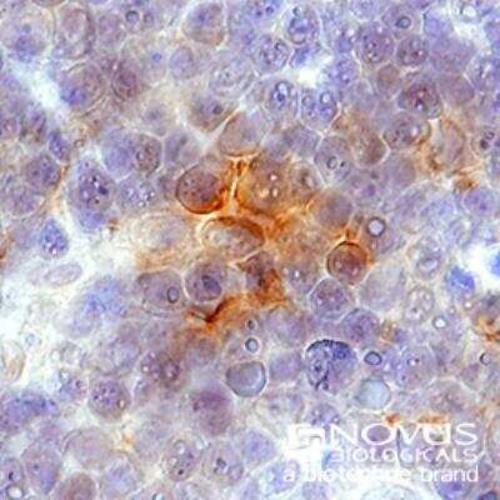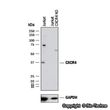CXCR4 Rabbit Polyclonal Antibody
Frequently bought together (2)
Transient overexpression lysate of chemokine (C-X-C motif) receptor 4 (CXCR4), transcript variant 2
USD 396.00
Other products for "CXCR4"
Specifications
| Product Data | |
| Applications | WB |
| Recommended Dilution | Western Blot: 1 - 2 ug/mL, Immunohistochemistry: 1:10 - 1:500, Immunocytochemistry/ Immunofluorescence, Knockdown Validated, Immunohistochemistry-Frozen), Immunohistochemistry-Paraffin: 1:10 - 1:500 |
| Reactivities | Human, Mouse, Rat, Sheep |
| Host | Rabbit |
| Clonality | Polyclonal |
| Immunogen | Rabbit anti-CXCR4 polyclonal antibody was raised against a peptide corresponding to amino acids 328-338 of human CXCR4. |
| Formulation | PBS containing 0.05% BSA, 0.05% Sodium Azide. Store at 4C short term. Aliquot and store at -20C long term. Avoid freeze-thaw cycles. |
| Concentration | lot specific |
| Purification | Protein G purified |
| Conjugation | Unconjugated |
| Storage | Store at -20°C as received. |
| Stability | Stable for 12 months from date of receipt. |
| Gene Name | C-X-C motif chemokine receptor 4 |
| Database Link | |
| Background | Human immunodeficiency virus (HIV) and related viruses require coreceptors, in addition to CD4, to infect target cells. Some G protein-coupled receptors including CCR5, CXCR4, CCR3, CCR2b and CCR8 in the chemokine receptor family, and four new human molecules GPR15, STRL33, GPR1 and V28 were recently identified as HIV coreceptors1. Among them, CXCR4 (fusin, LESTR or HUMSTR) is a principal coreceptor for T-cell tropic strains of HIV-1 fusion and entry of human white blood cells (2,3). CXCR4 is also required for the infection by dual-tropic strains of HIV-1 and mediates CD-4 independent infection by HIV-2 (4,5). The a-chemokine SDF-1 is the ligand for CXCR4 and prevents infection by T-tropic HIV-1 (6,7). CXCR4 associates with the surface CD4-gp120 complex before HIV enters target cells (8). CXCR4 messenger RNA levels correlated with HIV-1 permissiveness in diverse human cell types (2). Antibodies to CXCR4 block HIV-1 and HIV-2 fusion and infection of human target cells (2,5,10). The amino-terminal domain and the second extracellular loop of CXCR4 serve as HIV biding sites (10,11). |
| Synonyms | CD184; D2S201E; FB22; HM89; HSY3RR; LAP-3; LAP3; LCR1; LESTR; NPY3R; NPYR; NPYRL; NPYY3R; WHIM |
| Note | Immunohistochemistry (cryosections): see Nimmagadda etl al (2010) for details. Immunohistochemistry (paraffin): see Zagzag (2005) and others for details. |
| Reference Data | |
| Protein Families | Druggable Genome, ES Cell Differentiation/IPS, GPCR, Transmembrane |
| Protein Pathways | Axon guidance, Chemokine signaling pathway, Cytokine-cytokine receptor interaction, Endocytosis, Leukocyte transendothelial migration |
Documents
| Product Manuals |
| FAQs |
| SDS |
{0} Product Review(s)
0 Product Review(s)
Submit review
Be the first one to submit a review
Product Citations
*Delivery time may vary from web posted schedule. Occasional delays may occur due to unforeseen
complexities in the preparation of your product. International customers may expect an additional 1-2 weeks
in shipping.






























































































































































































































































 Germany
Germany
 Japan
Japan
 United Kingdom
United Kingdom
 China
China






